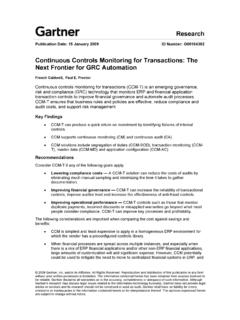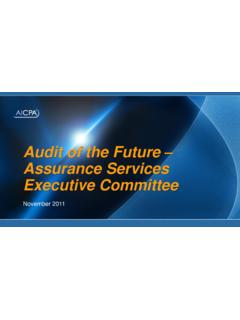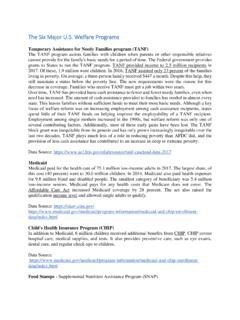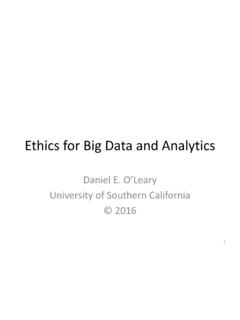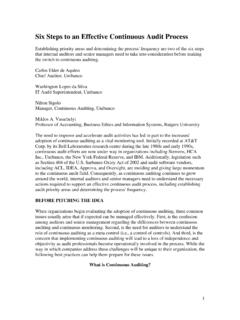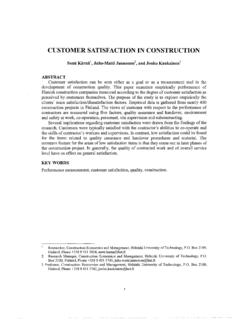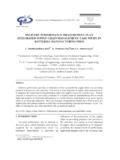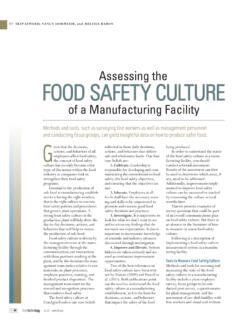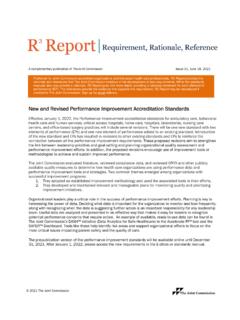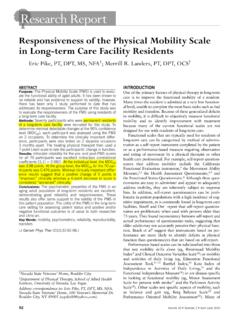Transcription of Remote Audit: A Review of Audit- Enhancing Information and ...
1 1 Remote Audit: A Review of Audit- Enhancing Information and Communication Technology literature Ryan A. Teeter, Rutgers, The State University of New Jersey, Miklos A. Vasarhelyi. Rutgers, The State University of New Jersey, Abstract: As internal audit management seeks to control costs, improve quality, and take full advantage of emerging business technology within their organization' the Remote audit becomes increasingly sensible. The integrated audit of the future, with real-time evidence feeds and both Remote and in loco components, will be very different from the current internal audit work and will eventually be also embraced by external auditors. During a Remote audit, internal auditors would interact with different departments and functions of the firm and third parties over long distances using Remote communication technology, such as web conferencing and Remote access to Information system clouds.
2 This paper is designed to 1) synthesize Information and literature found in areas from distance learning to operations management, and 2) present a framework for applying this technology to the Remote audit. The literature includes items from Remote audit, continuous audit, virtual organization theory, distance technology, and value proposition. Our focus is primarily on the technology that enables audit teams to work effectively and efficiently from a Remote location. I. Introduction The use of technology to enable Remote communication and execution of business processes is not new. Since the beginning of networked computing, researchers have identified characteristics of virtual organizations, observed the use of web conferencing and other Information and communication technologies (ICT), and sought to understand better how organizations can reap the benefits of streamlined Remote monitoring and control systems.
3 With respect to the financial audit, researchers and companies have developed advanced analytics and computer assisted auditing techniques (CAATs). These techniques enable auditors to evaluate data found within complex Information systems and provide assurance that the numbers these systems produce are an accurate reflection of the business. In this paper, we discuss some of the Remote technology and auditing techniques that exist and apply them to an enhanced, Remote -enabled internal audit. We define Remote auditing as the process by which auditors couple Information and communication technology with data analytics to assess the accuracy of financial data and internal controls, gather electronic evidence, and interact with clients, all without the need to be physically present.
4 The Remote audit can be utilized to aid a traditional periodic audit, and many of these components can be executed independently of one another. We envision the future of internal audit as a continuous process owned by management and implemented with three components: traditional, on-demand Remote , and agent-based continuous. While ICT can certainly enhance the traditional in loco audit, the Remote audit has the advantage of assessing risk and reliability on a real-time or on-demand basis. One key benefit is the change in attention span of the auditee. With a traditional audit, business processes experience an intense audit ramp-up where documentation and evidence are hastily compiled and systems cleaned immediately before the audit begins.
5 Once the auditor 2 leaves, the systems, processes, and deterrence atrophy until the next scheduled audit. With a Remote -enabled audit, the auditor becomes a perpetual proctor, monitoring to ensure that systems and procedures are in good condition and maintained. This was one of the primary goals of the continuous process auditing system developed at AT&T Bell Labs in the late 1980s (Vasarhelyi & Halper, 1991; Jans, 2010) The nature of audit evidence is changing as well. In the real-time economy, auditors are made aware of smooth operation, data problems, unusual events, changes in risk profile, or controls breakdown through a series of computer-based mechanisms. In a continuously audited system, individual transactions that fail a set of statistical tests send alerts to the auditors for immediate follow-up (audit by exception, Vasarhelyi & Halper, 1991).
6 Changes in documentation pass through a workflow in an electronic document management system. Internal controls settings in enterprise resource planning systems are set a baseline and monitored for deviation via continuous controls monitoring (Teeter & Brennan, 2010). The level of risk for different business processes is dynamically adjusted, based on algorithms inside a continuous risk measurement assessment. These systems can be designed to sift through vast amounts of data and automatically extract relevant Information . Trained auditors then verify this Information alongside their own manual extractions, copies of documentation, and interview notes. Audit support systems develop forensic models of detected anomaly patterns (fraud and error).
7 These filters are installed at the entry of processes to detect potential anomalies and for auditors / system managers to act on them. For the purposes of this paper, we limit our scope to the internal audit, which provides a systematic, disciplined approach to evaluate and improve the effectiveness of risk management, control, and governance processes. (IIA, 2010). This includes the monitoring of internal controls and the audit of IT systems. After a brief discussion of our vision of the future integrated Remote audit in the next section, our Review of the literature follows this order: section III discusses virtual organization theory, section IV evaluates current distance technology, section V describes analytics and continuous evidence, section VI presents a framework for a Remote audit, section VII identifies impacts of the Remote audit, and section VIII presents our concluding observations and suggestions for extensions of this work.
8 II. The Integrated Audit The role of internal audit has changed in the past decade. Aside from heightened expectations from management to provide assurance on internal controls and help the firm run more efficiently, internal auditors are increasingly being called upon to foot the evidence for the external audit, due in part to Auditing Standard 5 (PCAOB, 2005; Protiviti, 2008). At the same time, internal audit organizations are pressured to downsize operations and trim expenses, requiring greater efficiency on their part. There is a great need for a truly integrated audit. 3 Figure 1: Goals of the Integrated Audit The integrated audit meets the needs of management and external auditors while reducing latency, balancing in loco and Remote communication, and utilizing tools appropriate for collecting physical and electronic audit evidence, as shown in Figure 1.
9 We discuss these three attributes in this section. In loco and Remote audit The traditional audit is at odds with the real time economy s dynamic of change. While much of current business work is now team based and Remote , much of the current auditor interface is in loco (local) and face-to-face. Cost, method, and culture is pressing to change by creating an audit that uses both physical and virtual presence in the performance of assurance activities. We describe in Table 1 a set of activities and their potential method of execution divided into in loco and Remote audit. However, there are many forms of virtual presence facilitated by technology that are further discussed later in this paper. Table 1: In loco vs. Remote Audit Activities Activity In loco Remote audit Observations Client interface Initial kick-off meeting Experienced auditors meet with process managers Meeting via video conferencing Experienced auditors meet with process managers to get feeling and understanding of audit in person Interviews Auditor meets with specific parties in person Meeting conducted by phone, or video conferencing Lack of visual communication removes bias, non-verbal feedback Process mapping Auditor reviews documentation, tours facility Auditor evaluates flowcharts, verifies data flow in ERP system Depending on application.
10 Both are essential Knowledge engineering Offline documentation reviewed and updated Online documentation reviewed and updated Offline documentation would be digitized and kept in an EDMS Evidence collection Dashboard n/a Auditor alerted via web interface or e-mail when Audits can be performed around exceptions 4 analytics find a positive match Audit management Audit manager assesses risk based on interaction with processes managers, preliminary analysis Continuous risk monitoring provides automatic risk profiles for specific areas Automatic assessment aids audit planning Work papers Evidence gathered/stored offline Evidence gathered from/stored in online systems Online systems are centralized and accessible by any member of the team Latency Reduction Continuous monitoring n/a ERP systems run through analytical tests Auditors are alerted when controls failure occurs Continuous data assurance n/a Databases are checked for validity consistency Auditors are alerted when consistency checks fail Document versioning Paper documents are updated and old versions removed based on retention policy Digital documents are updated and purged in online systems based on
